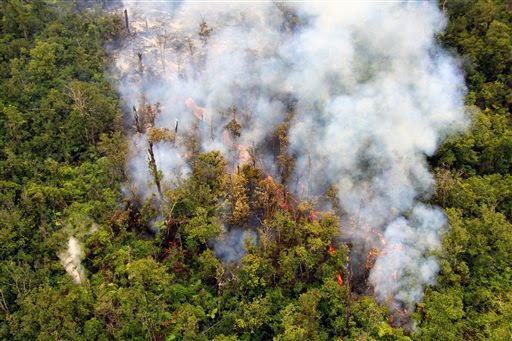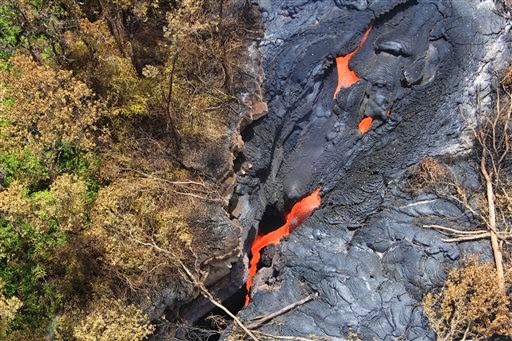
Residents in a rural, isolated region of Hawaii’s Big Island still reeling from a recent tropical storm turned their attention to a potential new disaster Thursday as scientists warned that a lava flow from a nearby volcano had moved closer to homes.
The Hawaiian Volcano Observatory said lava from the Kilauea volcano could reach the Kaohe Homesteads in five to seven days if it continues its steady advance through cracks in the earth.
The sparsely populated subdivision is part of the Puna region, where Tropical Storm Iselle made landfall about a month ago, toppling trees onto homes and wiping out electricity.
Observatory scientists said the lava has been advancing about 800 feet (243 meters) per day since July 10. They’ve been closely monitoring the flow and on Thursday raised the alert level from “watch” to “warning.”
However, the observatory said predicting a flow’s exact path can be difficult because of subtle variations in topography, changes in lava volume and where and how lava enters or exits ground cracks.

Hawaii County Civil Defense Administrator Darryl Oliveira said the agency has not yet ordered an evacuation but will do so when it’s clear the lava is at least five days from impacting homes.
“It’s very frustrating because even if we look at a five-day period and we tell people to evacuate, it could be weeks before anything happens,” Oliveira said.
Mayor Billy Kenoi is declaring an emergency, which will allow authorities to restrict access to roadways so Kaohe Homesteads residents can leave safely if an evacuation becomes necessary.
Officials said exactly how many people live in the subdivision made up of large, mostly agricultural lots is unclear, and county workers have been going door-to-door to conduct counts. Oliveira said his staff members so far have identified 20 to 30 households.
The county is asking all of Puna to be on alert because it’s possible the lava could change direction and threaten other communities, he said. It also is advising people to stay away from the Kaohe Homesteads.
When scientists first warned the public about the flow two weeks ago, people wanting a glimpse of the lava began taking helicopter tours over Kaohe and increasing traffic in the community, Oliveira said. He stressed that lava can’t be seen from the subdivision.
The Kilauea volcano has been continuously erupting since 1983, but new vents—or points where lava reaches the surface—have opened periodically. Lava from the volcano normally doesn’t approach homes, but it did wipe out neighborhoods in 1990.
The last time an evacuation was ordered was in 2011, recalled Oliveira, who was fire chief at the time. He said the lava destroyed one home before changing course and sparing others.
Most of the lava flows from Kilauea’s east rift zone have pushed south, but this recent flow is moving northeast, which is unusual but not unprecedented, according to the observatory.
Note : The above story is based on materials provided by © 2014 The Associated Press. All rights reserved.









